Topics
Category
Era
O'Connor Layover Agreement
The O'Connor layover agreement was instituted by John O'Connor shortly after his promotion from St. Paul detective to chief of police on June 11, 1900. It allowed criminals to stay in the city under three conditions: that they checked in with police upon their arrival; agreed to pay bribes to city officials; and committed no major crimes in the city of St. Paul. This arrangement lasted for almost forty years, ending when rampant corruption forced crusading local citizens and the federal government to step in.
After becoming police chief, O'Connor re-organized the police force and gave himself nearly absolute power. He then reached out to criminals throughout the Midwest, letting them know that St. Paul was a safe place for them. He promised that the police would disregard offenders who performed their deeds beyond St. Paul as long as they remained law abiding while in the city.
To accomplish his plan, O'Connor required a liaison from within the criminal ranks to keep an eye on his peers. William "Reddy" Griffin was the first keeper of O'Connor's system. After arriving in town and meeting with the police, criminals stopped to "check in" with Griffin at the Hotel Savoy in downtown St. Paul. Among his many duties, Griffin collected bribes and brought the money to O'Connor. When Griffin died of apoplexy in 1913 at the age of sixty-five, "Dapper" Dan Hogan took over his role.
Thanks to the layover agreement, St. Paul in the first half of the twentieth century became a refuge for many of the most notorious gangsters of modern American history. John Dillinger and Billie Frechette, Ma Barker and her boys, "Babyface" Nelson, Alvin Karpis, and others considered St. Paul a safe haven at some point during their "careers." Minnesota became an epicenter of illegal activity, with major crimes committed across the state. While surrounding towns and cities suffered, St. Paul remained nearly free of major crime.
The layover agreement remained in force for so long because each side benefited financially. As long as criminals stayed in the city, bribes flowed toward corrupt officials and the system remained intact. It was so lucrative that criminals policed their colleagues to ensure that no one ruined a good thing. If anyone broke O'Connor's rules, the "heat" would be too hot to overcome, and the financial windfall would quickly come to an end.
O'Connor retired from the police force on May 29, 1920. A car bomb killed Hogan on December 4, 1928; his murder remains unsolved. The layover system persisted, but without O'Connor's heavy hand to police it, things began to change. St. Paul's crime rate eventually surged. The city that had enjoyed a reputation for safety in the 1920s became a "poison spot of crime" in the eyes of the nation.
When Prohibition ended in 1933, the city's criminals took over. No longer able to make money selling illegal liquor, many turned to ransom. In June, the city was shocked to learn of the kidnapping of Hamm Brewing Company president William Hamm Jr. by the Barker‒Karpis gang. In January of 1934 the gang struck again, this time carrying off Schmidt Brewing Company heir Edward Bremer. The kidnapping of such public figures alerted the nation and forced the federal government to intervene.
The arrival of federal agents in St. Paul spelled the beginning of the end of the layover agreement. Under surveillance by a higher authority, local officials could no longer ignore crime and accept bribes with impunity. In 1934 the federal government passed a series of crime laws that increased the FBI's jurisdiction. This allowed the Bureau to attack the gangster menace throughout the country.
That same year, frustrated St. Paul citizens, led by journalist Howard Kahn, took the fight to local corruption. Chicago detective Jamie Wallace, hired by Kahn and Commissioner of Public Safety Henry Warren, wiretapped the St. Paul Police Department for over a year. Those wiretaps exposed a bevy of crimes and provided transcripts of officials tipping off organized crime members. In July 1935, reporters at Kahn's newspaper (the St. Paul Daily News) wrote a story about corruption within the police ranks.
The O'Connor layover agreement ended in 1935 with the conviction or resignation of many of the city's police force. The old guard was gone, and the new guard made sure that O'Connor's system did not return.
Bibliography
High, Stanley. "St. Paul Wins a War." Current History 49, no. 1 (September 1938): 18–20.
Maccabee, Paul. John Dillinger Slept Here: A Crooks' Tour of Crime and Corruption in St. Paul, 1920–1936. St. Paul: Minnesota Historical Society Press, 1995.
Mahoney, Tim. Secret Partners: Big Tom Brown and the Barker Gang. St. Paul: Minnesota Historical Society Press, 2013.
Moley, Raymond, and Edgar Sisson. "Crime Marches On: St. Paul-Gangster's Paradise." Today, June 23, 1934.
Nickel, Steven, and William J. Helmer. Baby Face Nelson: Portrait of a Public Enemy. Nashville, TN: Cumberland House, 2002.
Related Resources
Primary
Criminal history files, 1928–1982 (bulk 1928–1955)
Minnesota Bureau of Criminal Apprehension
State Archives Collection, Minnesota Historical Society, St. Paul
http://www2.mnhs.org/library/findaids/pubsaf08.xml
Description: Fifty-one criminal history files, mainly documenting high-profile 1930s gangsters, including Arthur "Doc" and Fred Barker, John Dillinger, Alvin Karpis, and George "Baby Face" Nelson.
Secondary
St. Paul gangster history research collection, 1981–1995
Manuscript Collection, Minnesota Historical Society, St. Paul
http://www2.mnhs.org/library/findaids/00239.xml
Description: Research and interview notes; correspondence; and photocopies of original records created or compiled by Paul Maccabee for his book John Dillinger Slept Here.
Videotape #391
Audiovisual Collection, Minnesota Historical Society, St. Paul
Brede, Neil. St. Paul's Gangster Days. VHS. St. Paul: Cable Access, [1990?].
Description: This documentary uses historical photographs, newspapers and interviews to examine St. Paul's reputation as a haven for many of the nation's criminals which led to a crime wave in the 1930s.
Web
Brady, Tim. "Crime Capital." Minnesota Monthly, April 2007.
http://www.minnesotamonthly.com/media/Minnesota-Monthly/April-2007/Crime-Capital/
"Young Detective Smashes Police Ring." Modern Mechanix, July 1936.
Originally Found at: http://blog.modernmechanix.com/young-detective-smashes-police-ring/
Related Audio
MN90: R 'N R for Gangsters
In the 1930s, St. Paul became a safe haven for every bank robber, stickup artist, and kidnapper in America. MN90 producer Marisa Helms explains.
All rights reserved
More Information
Articles
Related Images
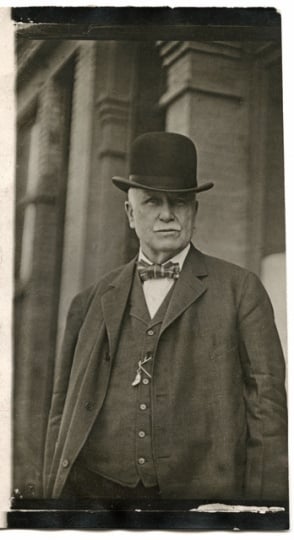
John O'Connor, Chief of St. Paul Police
John O'Connor during the height of his power in St. Paul, c.1912.
Public domain
Holding Location
More Information
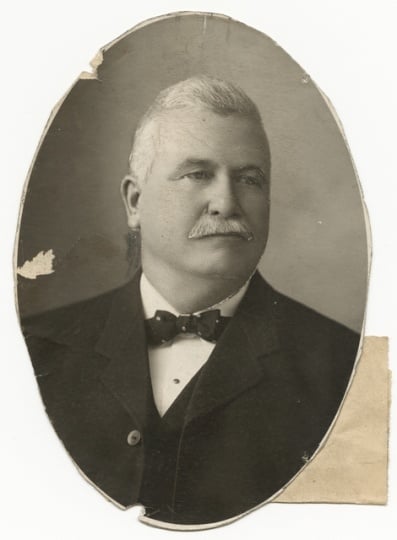
John J. O'Connor, Chief of the St. Paul Police Department
Police chief John O'Connor, c.1900.
Public domain
Holding Location
Articles
More Information
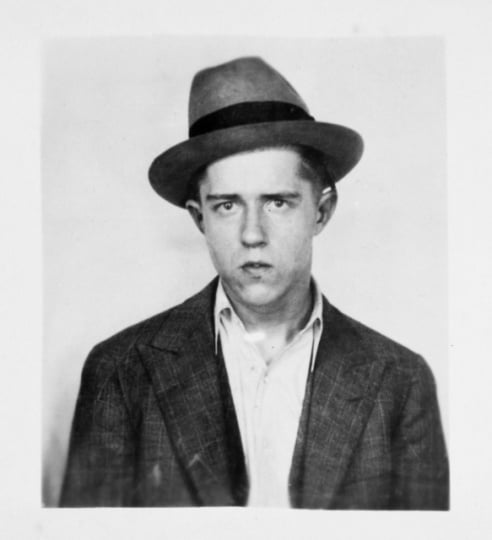
Alvin Karpis
Gangster Alvin Karpis, c.1925. Photograph by the Bureau of Criminal Apprehension.
Public domain
Holding Location
Articles
More Information
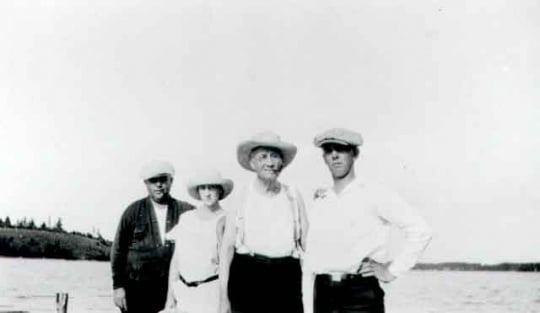
"Dapper" Dan Hogan (left), owner of the Green Lantern Saloon in St. Paul at Big Bass Lake near Bemidji
Daniel Hogan (far left) and family, c.1926. Hogan was instrumental in the operation of the O'Connor layover system.
Holding Location
Articles
More Information
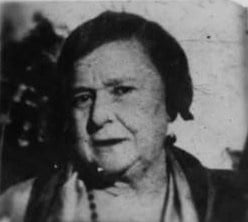
Ma Barker (Mrs. Arrie Barker, also known as Mrs. George Anderson)
"Ma" Barker, reported member of the Barker-Karpis gang, 1931. Photograph by the Bureau of Criminal Apprehension.
Public domain
Holding Location
More Information
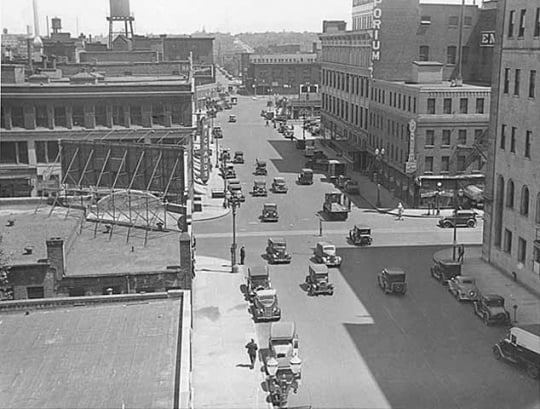
Intersection at Eighth and Robert looking down Eighth, St. Paul
Downtown St. Paul at the intersection of Eighth and Robert Streets, c.1932.
Holding Location
Articles
More Information
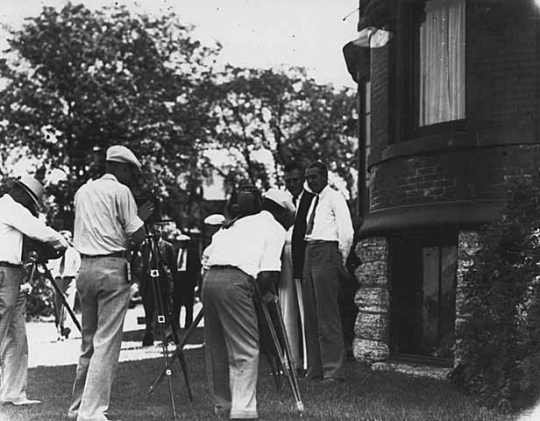
William Hamm Jr. talking with reporters upon his return
William Hamm Jr. talking with reporters after his safe return from kidnapping, 1933.
Holding Location
Articles
More Information
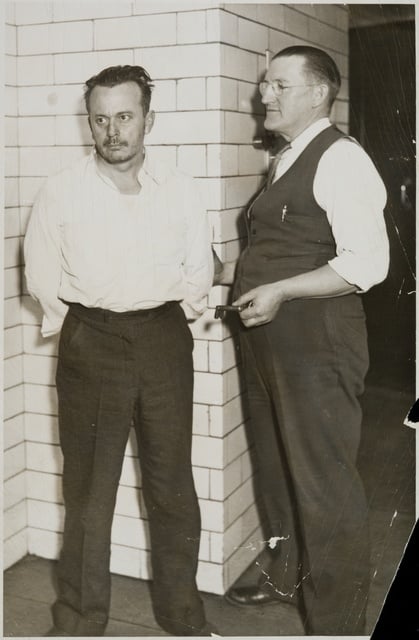
Arthur "Doc" Barker (suspect in Edward Bremer kidnapping) and jailer, William Gates
Arthur "Doc" Barker (suspect in Edward Bremer kidnapping) and jailer, William Gates, 1935. Photograph by the St. Paul Daily News.
Holding Location
Articles
More Information
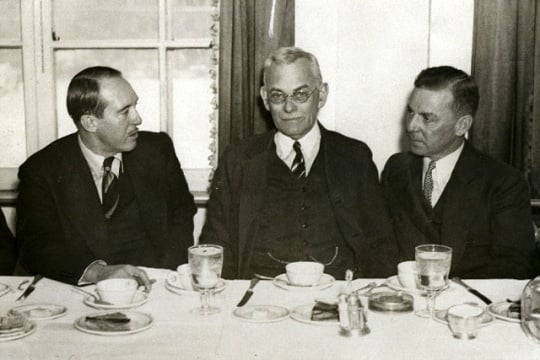
Howard Kahn, City Editor of the St. Paul Daily News (far right) with Webb Miller (center) and J. N. Jackson
Howard Kahn (far right), 1936. Through his editorial efforts, Kahn helped bring about the end of the layover agreement. Photograph by the St. Paul Daily News.
Holding Location
Articles
More Information
Related Articles
Turning Point
On January 17, 1934, the Barker‒Karpis gang kidnaps Schmidt Brewing Company heir Edward Bremer. Investigation of the kidnapping draws national attention to criminal activity in St. Paul.
Chronology
1900
1920
1924
1928
June 15, 1933
August 30, 1933
January 17, 1934
1934
July 24, 1935
1935
Bibliography
High, Stanley. "St. Paul Wins a War." Current History 49, no. 1 (September 1938): 18–20.
Maccabee, Paul. John Dillinger Slept Here: A Crooks' Tour of Crime and Corruption in St. Paul, 1920–1936. St. Paul: Minnesota Historical Society Press, 1995.
Mahoney, Tim. Secret Partners: Big Tom Brown and the Barker Gang. St. Paul: Minnesota Historical Society Press, 2013.
Moley, Raymond, and Edgar Sisson. "Crime Marches On: St. Paul-Gangster's Paradise." Today, June 23, 1934.
Nickel, Steven, and William J. Helmer. Baby Face Nelson: Portrait of a Public Enemy. Nashville, TN: Cumberland House, 2002.
Related Resources
Primary
Criminal history files, 1928–1982 (bulk 1928–1955)
Minnesota Bureau of Criminal Apprehension
State Archives Collection, Minnesota Historical Society, St. Paul
http://www2.mnhs.org/library/findaids/pubsaf08.xml
Description: Fifty-one criminal history files, mainly documenting high-profile 1930s gangsters, including Arthur "Doc" and Fred Barker, John Dillinger, Alvin Karpis, and George "Baby Face" Nelson.
Secondary
St. Paul gangster history research collection, 1981–1995
Manuscript Collection, Minnesota Historical Society, St. Paul
http://www2.mnhs.org/library/findaids/00239.xml
Description: Research and interview notes; correspondence; and photocopies of original records created or compiled by Paul Maccabee for his book John Dillinger Slept Here.
Videotape #391
Audiovisual Collection, Minnesota Historical Society, St. Paul
Brede, Neil. St. Paul's Gangster Days. VHS. St. Paul: Cable Access, [1990?].
Description: This documentary uses historical photographs, newspapers and interviews to examine St. Paul's reputation as a haven for many of the nation's criminals which led to a crime wave in the 1930s.
Web
Brady, Tim. "Crime Capital." Minnesota Monthly, April 2007.
http://www.minnesotamonthly.com/media/Minnesota-Monthly/April-2007/Crime-Capital/
"Young Detective Smashes Police Ring." Modern Mechanix, July 1936.
Originally Found at: http://blog.modernmechanix.com/young-detective-smashes-police-ring/










